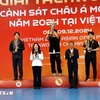US army photographer Ronald Haeberle who took photos of the My Lai massacre in 1968 returned to the site in Son My, Tinh Khe commune, Son Tuong district in central Quang Ngai province on Oct. 24.
The photos served as undeniable evidence of the mass killings that forced the White House to open an investigation in the case.
Forty-three years after the incident, Haeberle came back to Son My as a witness of the massacre. He also helped the Son My Museum make more accurate captions for the photos.
The mass killings occurred on March 16, 1968 in the hamlet of My Lai, Son Tich district, Quang Ngai province. The massacre began when US soldiers under the command of Lieutenant William Calley opened fire on civilians during a "search and destroy" mission in My Lai and neighbouring villages.
The targets of the killings were mainly old men, women and children – all unarmed – as most younger males of the My Lai community were working in the fields. More than 500 people were massacred that day./.
The photos served as undeniable evidence of the mass killings that forced the White House to open an investigation in the case.
Forty-three years after the incident, Haeberle came back to Son My as a witness of the massacre. He also helped the Son My Museum make more accurate captions for the photos.
The mass killings occurred on March 16, 1968 in the hamlet of My Lai, Son Tich district, Quang Ngai province. The massacre began when US soldiers under the command of Lieutenant William Calley opened fire on civilians during a "search and destroy" mission in My Lai and neighbouring villages.
The targets of the killings were mainly old men, women and children – all unarmed – as most younger males of the My Lai community were working in the fields. More than 500 people were massacred that day./.



















